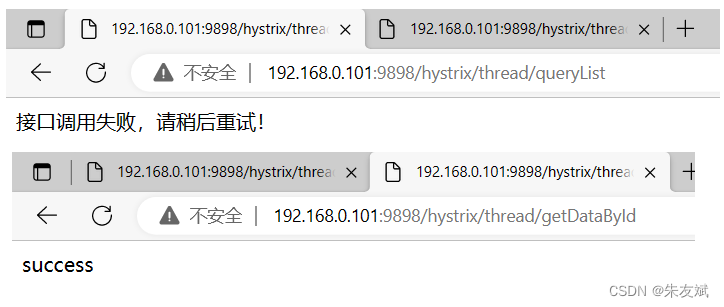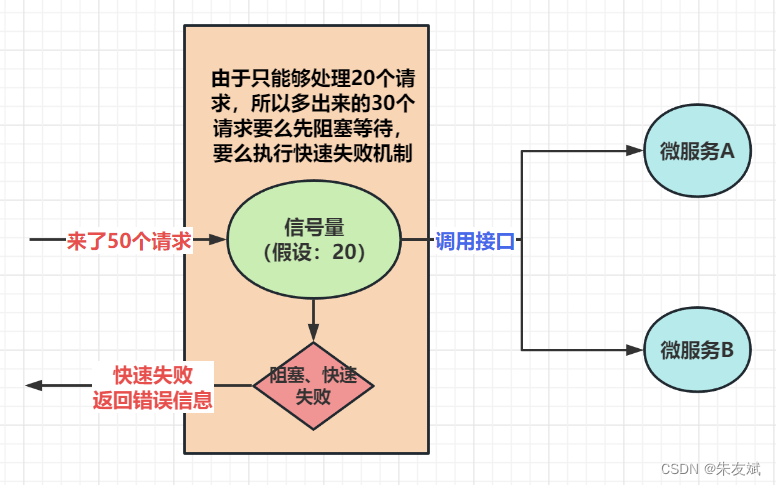这篇文章,主要介绍微服务组件之Hystrix实现线程池隔离和信号量隔离。
目录

一、线程池隔离
1.1、线程池隔离介绍
在一个微服务中,所有的接口如果都是运行在同一个线程池里面,那么如果其中某一个接口出现大量的请求,并且这个接口又没办法处理过来,这个时候服务就可能会出现资源耗尽的情况,从而导致整个服务崩溃。所以,Hystrix为了解决这个问题,提出了线程池隔离的方案,将不同的接口放到不同的线程池里面进行管理,并且不同的线程池互不干扰,这样即使其中一个线程池发生故障,也不会影响其他的线程池,也就降低了服务崩溃的可能性。

线程池隔离虽然解决了服务崩溃的问题,但是同时也带来了一个问题,那就是线程的创建和销毁是需要消耗系统资源的,如果采用线程池隔离,当这个微服务的请求越来越大,对应的线程也就会创建的越来越多,这就会导致线程的切换非常频繁,从而也就降低了系统的一个性能。线程池隔离适用于隔离实例较少的场景里面。
1.2、实现线程池隔离
(1)引入依赖
<!--hystrix 依赖-->
<dependency>
<groupId>org.springframework.cloud</groupId>
<artifactId>spring-cloud-starter-netflix-hystrix</artifactId>
</dependency>(2)编写Service层代码
在service服务层中,我们在需要开启线程池隔离的方法上面,使用【@HystrixCommand】注解进行标记。
package com.gitcode.hystrix.service;
import com.netflix.hystrix.contrib.javanica.annotation.HystrixCommand;
import com.netflix.hystrix.contrib.javanica.annotation.HystrixProperty;
import org.springframework.stereotype.Service;
/**
* @version 1.0.0
* @Date: 2023/4/9 19:49
* @Copyright (C) ZhuYouBin
* @Description:
*/
@Service
public class HystrixThreadService {
@HystrixCommand(
// 命令key,默认是当前方法名称
commandKey = "firstCommandKey",
// 线程池分组的key
groupKey = "queryList-thread-pool",
// 线程池的key,可以和 groupKey 设置相同
threadPoolKey = "queryList-thread-pool",
// 设置 hystrix 命令的属性
commandProperties = {
// 设置线程池隔离的超时时间,默认是1000ms
@HystrixProperty(name = "execution.isolation.thread.timeoutInMilliseconds", value = "5000")
},
// 设置线程池的属性
threadPoolProperties = {
// 核心线程大小
@HystrixProperty(name = "coreSize", value = "4"),
// 队列大小
@HystrixProperty(name = "maxQueueSize", value = "100"),
// 存活时间,默认是 1 分钟,单位是分钟
@HystrixProperty(name = "keepAliveTimeMinutes", value = "2"),
// 超出队列执行拒绝策略的阈值
@HystrixProperty(name = "queueSizeRejectionThreshold", value = "100"),
},
// 设置快速失败时候调用的方法,可以写,也可以不写,写了就会执行快速失败,不写就阻塞等待
fallbackMethod = "fallbackDemo"
)
public String queryList() {
// TODO 这里模拟调用其他微服务
try {
Thread.sleep(6000);
System.out.println("微服务调用成功:" + Thread.currentThread().getName());
} catch (Exception e) {}
return "success";
}
@HystrixCommand(
// 命令key,默认是当前方法名称
commandKey = "secondCommandKey",
// 线程池分组的key
groupKey = "getDataById-thread-pool",
// 线程池的key,可以和 groupKey 设置相同
threadPoolKey = "getDataById-thread-pool",
// 设置 hystrix 命令的属性
commandProperties = {
// 设置线程池隔离的超时时间,默认是1000ms
@HystrixProperty(name = "execution.isolation.thread.timeoutInMilliseconds", value = "5000")
},
// 设置线程池的属性
threadPoolProperties = {
// 核心线程大小
@HystrixProperty(name = "coreSize", value = "2"),
// 队列大小
@HystrixProperty(name = "maxQueueSize", value = "100"),
// 存活时间,默认是 1 分钟,单位是分钟
@HystrixProperty(name = "keepAliveTimeMinutes", value = "2"),
// 超出队列执行拒绝策略的阈值
@HystrixProperty(name = "queueSizeRejectionThreshold", value = "100"),
}
)
public String getDataById() {
// TODO 这里模拟调用其他微服务
System.out.println("微服务调用成功:" + Thread.currentThread().getName());
return "success";
}
public String fallbackDemo() {
return "接口调用失败,请稍后重试!";
}
}
(3)编写Controller层代码
package com.gitcode.hystrix.controller;
import com.gitcode.hystrix.service.HystrixThreadService;
import org.springframework.beans.factory.annotation.Autowired;
import org.springframework.web.bind.annotation.GetMapping;
import org.springframework.web.bind.annotation.RequestMapping;
import org.springframework.web.bind.annotation.RestController;
/**
* @version 1.0.0
* @Date: 2023/4/9 19:47
* @Copyright (C) ZhuYouBin
* @Description: Hystrix 线程池隔离
*/
@RestController
@RequestMapping("/hystrix/thread")
public class HystrixThreadController {
@Autowired
private HystrixThreadService hystrixThreadService;
@GetMapping("/queryList")
public String queryList() {
return hystrixThreadService.queryList();
}
@GetMapping("/getDataById")
public String getDataById() {
return hystrixThreadService.getDataById();
}
}
(4)运行测试
启动应用,浏览器访问两个接口。

二、信号量隔离
2.1、信号量隔离介绍
采用线程池隔离,可能会导致线程过多而降低系统的性能,所以为了解决这个问题,Hystrix又提出了一个信号量隔离。信号量隔离是采用同步阻塞等待的思想,它通过设置一个信号量,这个信号量用于表示可以同时访问的最大请求数量,当系统中到达的请求数量超过这个信号量之后,超出的请求就会处于阻塞状态,或者直接采用快速失败机制,返回一个错误提示。

信号量隔离,不会产生新的线程,所以也就不会存在大量线程之间的来回切换;但是信号量隔离也存在缺点,它不支持超时设置,所以它适用于非网络请求的。
2.2、实现信号量隔离
(1)引入依赖
<!--hystrix 依赖-->
<dependency>
<groupId>org.springframework.cloud</groupId>
<artifactId>spring-cloud-starter-netflix-hystrix</artifactId>
</dependency>(2)编写Service层代码
信号量隔离,也是使用【@HystrixCommand】注解,指定隔离策略是【信号量隔离】即可。
package com.gitcode.hystrix.service;
import com.netflix.hystrix.contrib.javanica.annotation.HystrixCommand;
import com.netflix.hystrix.contrib.javanica.annotation.HystrixProperty;
import org.springframework.stereotype.Service;
/**
* @version 1.0.0
* @Date: 2023/4/9 19:49
* @Copyright (C) ZhuYouBin
* @Description: 信号量隔离
*/
@Service
public class HystrixSemaphoreService {
@HystrixCommand(
// 设置 hystrix 命令的属性
commandProperties = {
// 设置线程池隔离的超时时间,默认是1000ms
@HystrixProperty(name = "execution.isolation.thread.timeoutInMilliseconds", value = "5000"),
// 设置隔离策略是【信号量隔离】,默认是线程池隔离
@HystrixProperty(name = "execution.isolation.strategy", value = "SEMAPHORE"),
// 设置信号量最大请求数, 超过最大信号量数量,如果写了 fallbackMethod 属性,则会调用快速失败方法
@HystrixProperty(name = "execution.isolation.semaphore.maxConcurrentRequests", value = "4")
},
// 设置快速失败时候调用的方法,可以写,也可以不写,写了就会执行快速失败,不写就阻塞等待
fallbackMethod = "fallbackDemo"
)
public String queryList() {
// TODO 这里模拟调用其他微服务
System.out.println("微服务调用成功:" + Thread.currentThread().getName());
return "success";
}
public String fallbackDemo() {
System.out.println("接口调用失败,请稍后重试!");
return "接口调用失败,请稍后重试!";
}
}
(3)编写Controller层代码
package com.gitcode.hystrix.controller;
import com.gitcode.hystrix.service.HystrixSemaphoreService;
import org.springframework.beans.factory.annotation.Autowired;
import org.springframework.web.bind.annotation.GetMapping;
import org.springframework.web.bind.annotation.RequestMapping;
import org.springframework.web.bind.annotation.RestController;
/**
* @version 1.0.0
* @Date: 2023/4/9 19:47
* @Copyright (C) ZhuYouBin
* @Description: Hystrix 信号量隔离
*/
@RestController
@RequestMapping("/hystrix/semaphore")
public class HystrixSemaphoreController {
@Autowired
private HystrixSemaphoreService hystrixSemaphoreService;
@GetMapping("/queryList")
public String queryList() {
return hystrixSemaphoreService.queryList();
}
}
(4)运行测试
启动应用,使用jemeter模拟并发请求,查看控制台输入日志。

到此,Hystrix实现线程池隔离和信号量隔离就介绍完啦。
综上,这篇文章结束了,主要介绍微服务组件之Hystrix实现线程池隔离和信号量隔离。